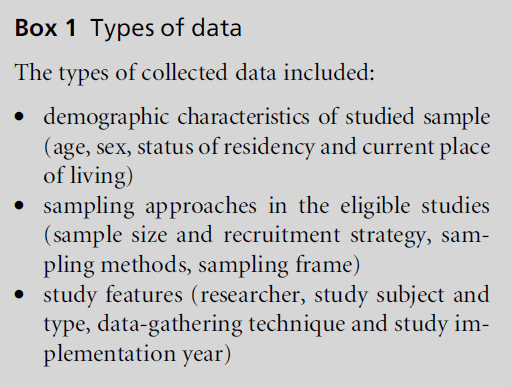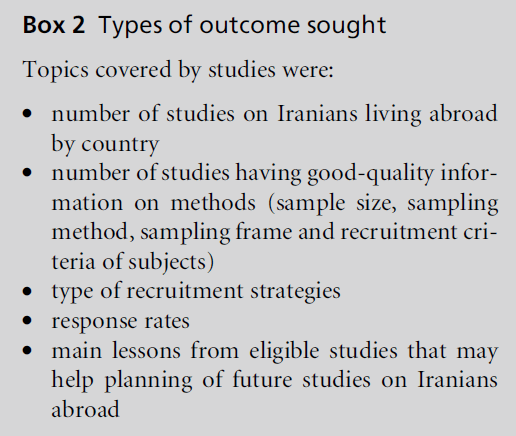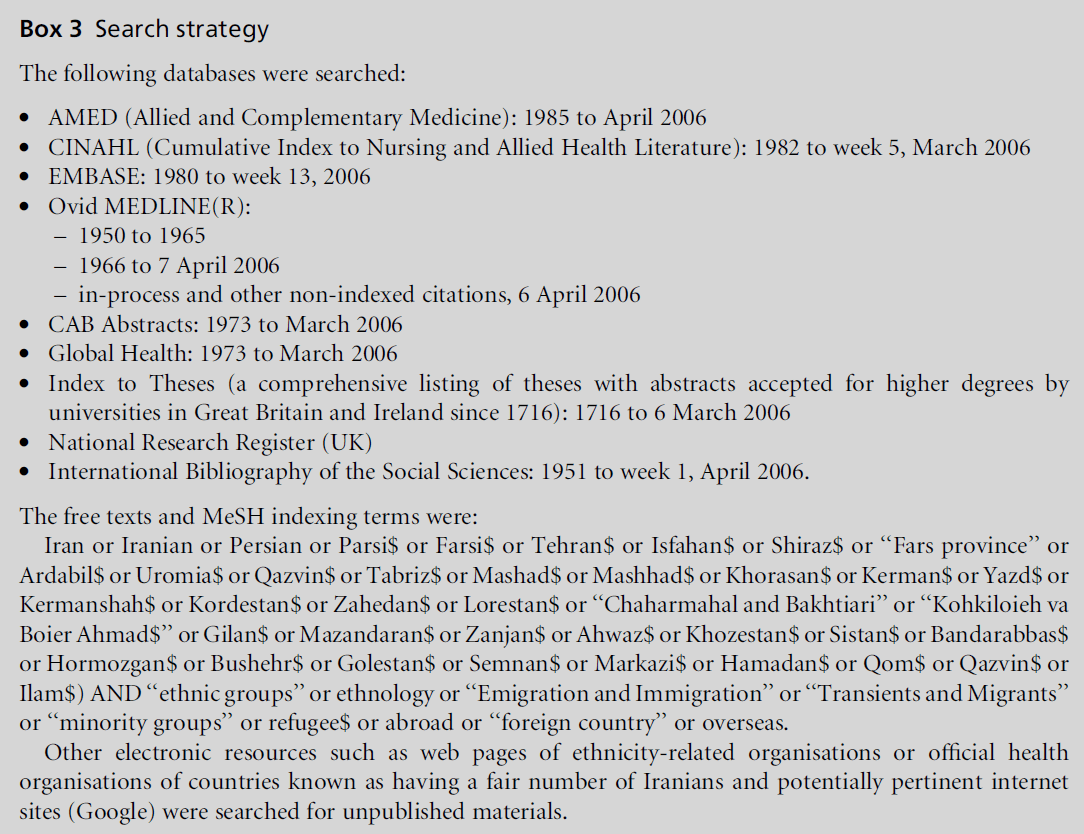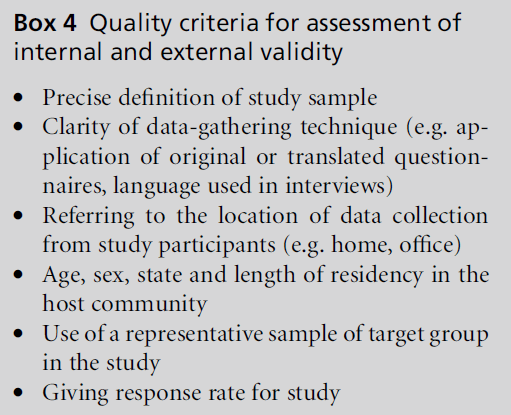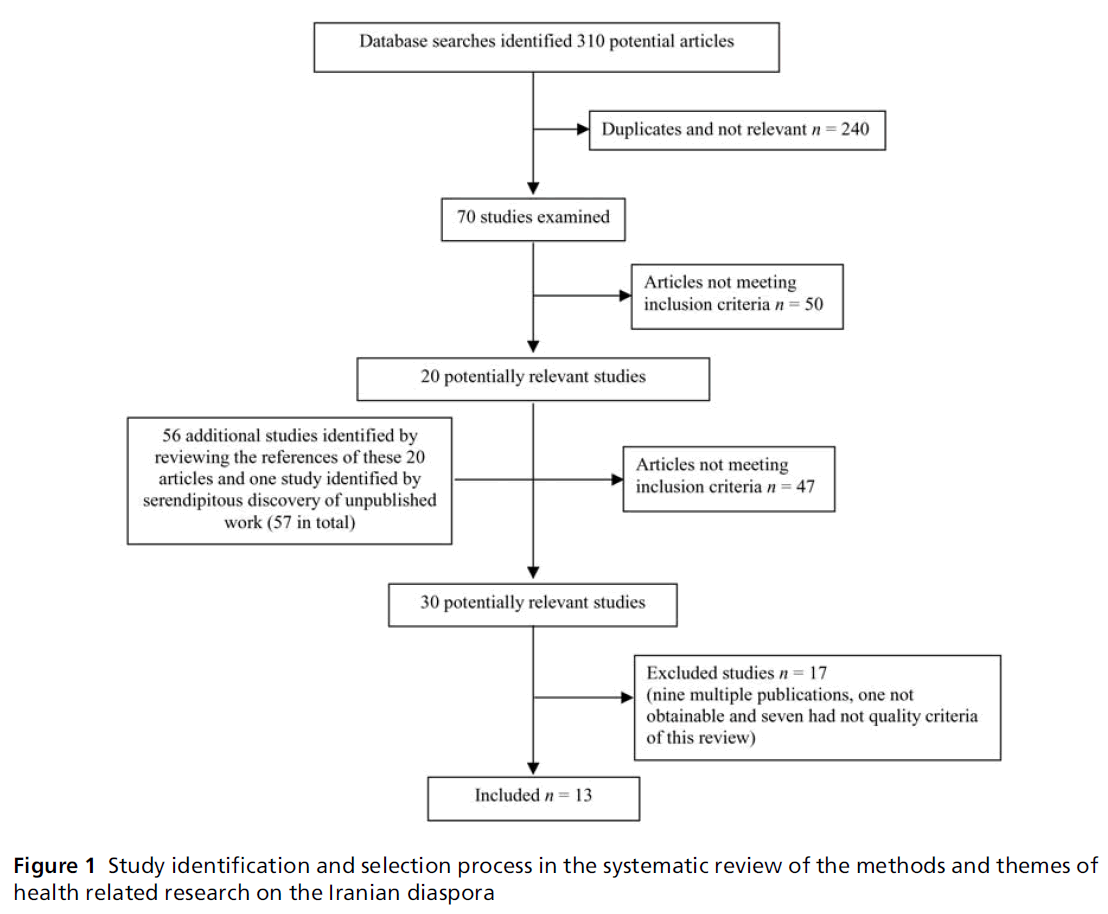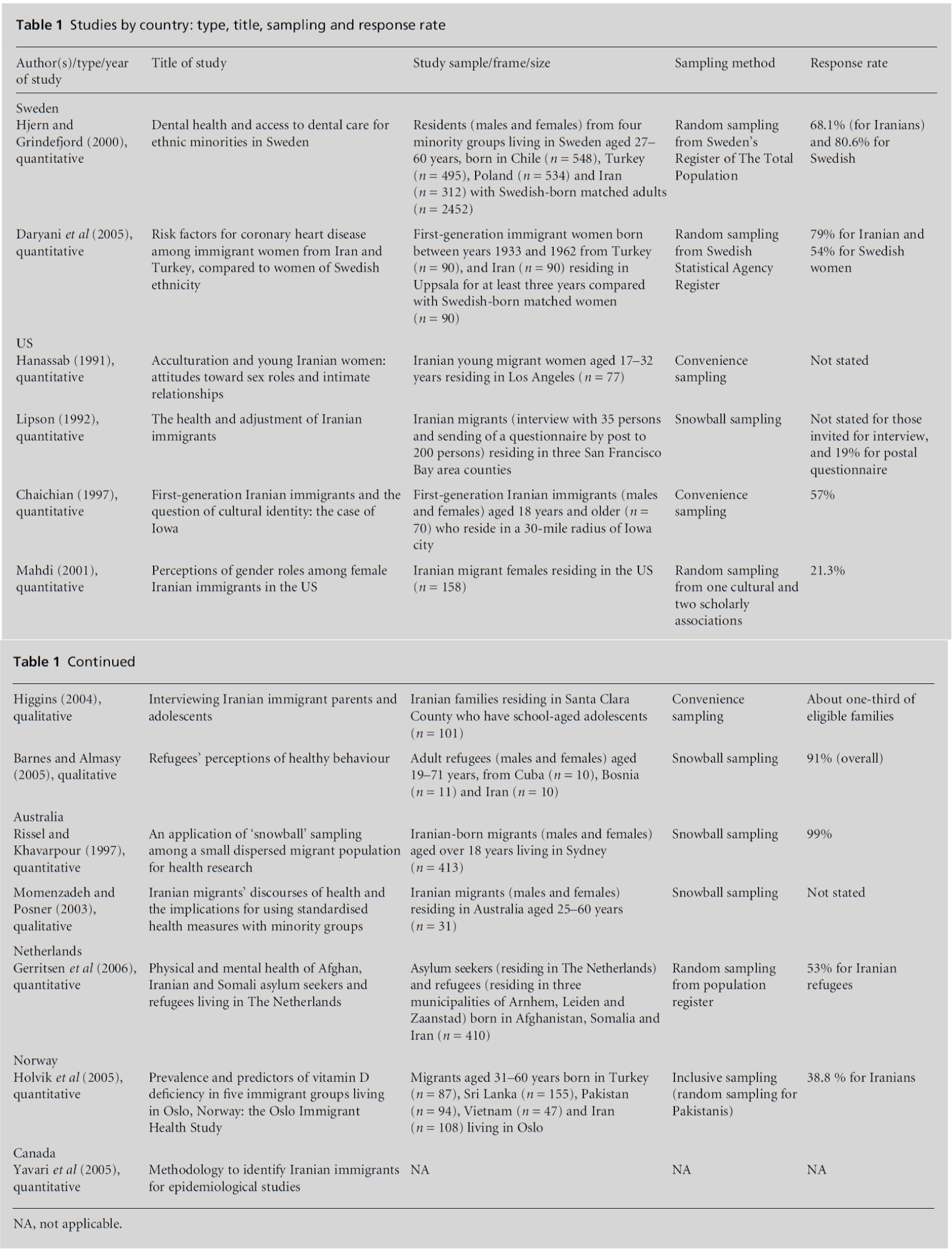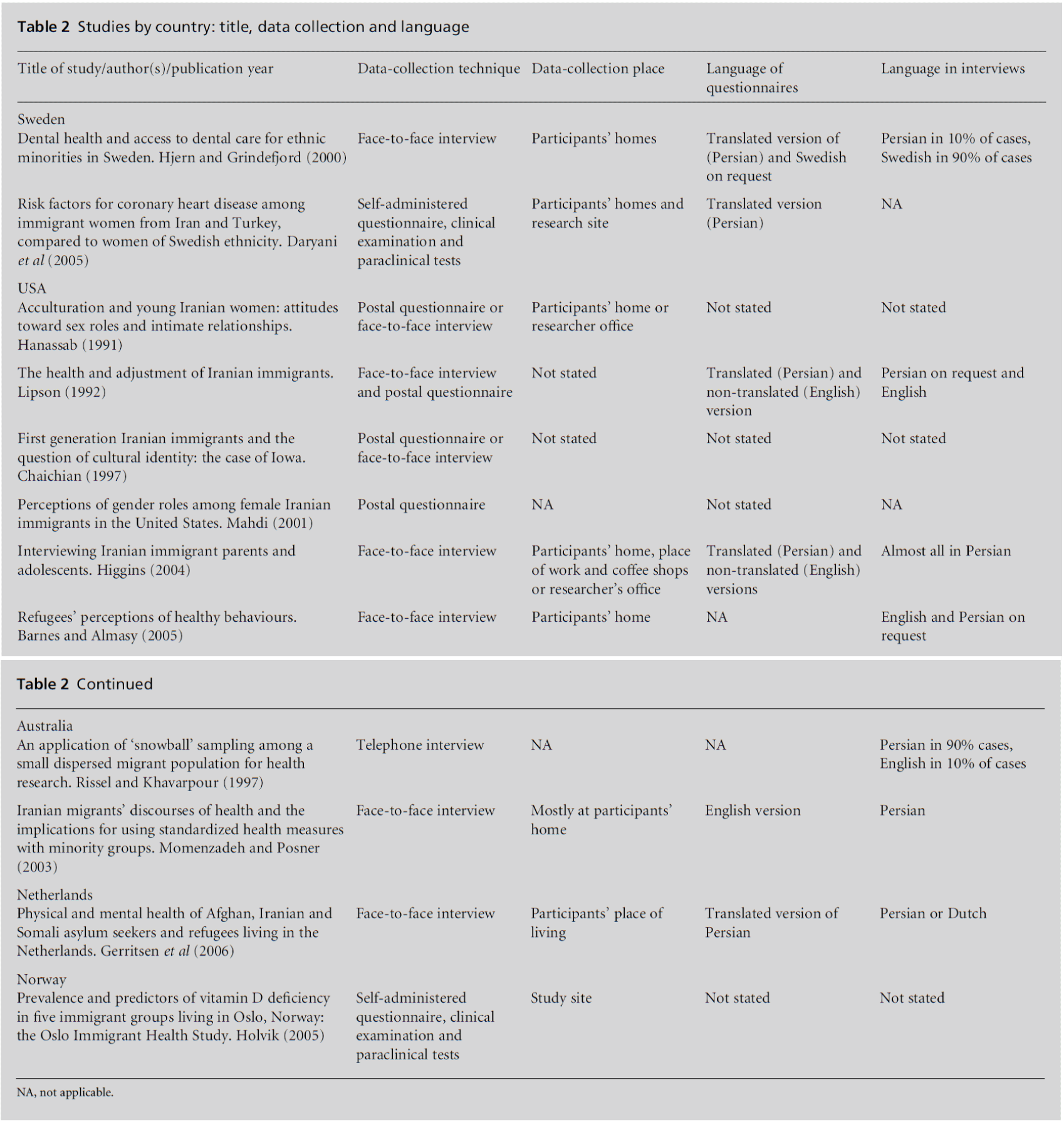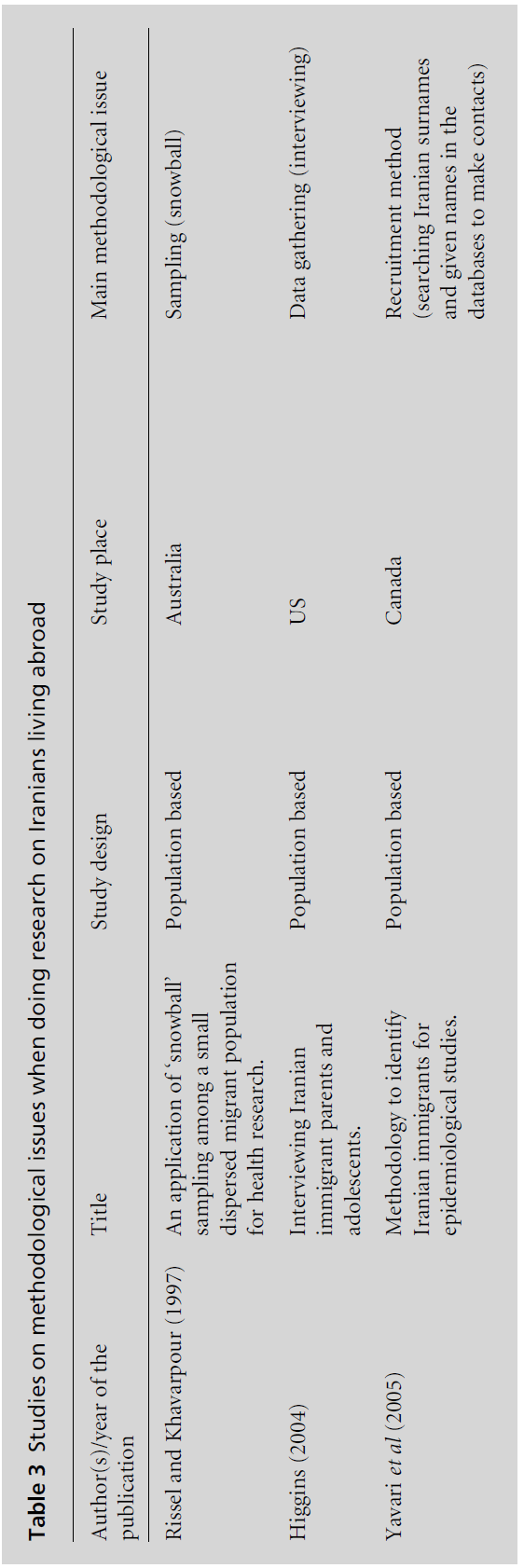Keywords
ethnic group, healthcare, Iran, migrant,
research, sampling, studies
Introduction
In studying ethnic groups as discrete communities,
researchers are endeavouring to contribute to improving
health and reducing health inequalities. However,
they often encounter difficulties, particularly in
identifying and recruiting the planned number of
participants. There are many potential explanations
for this, including lack of knowledge about the sociocultural
features of each individual ethnic group. A
rigorous look at recruitment strategies and sociocultural
attributes of potential participants is therefore
extremely important in the planning phase of research
on ethnic minority groups. Research on Iranian populations
living abroad provides one example of the
difficulties that researchers may experience, and forms
the subject of this article.
There has been increasing migration from Iran in
the last three decades, and Iranians now form one of
the largest groups in a growing Middle-Eastern diaspora.
Iranian migration accelerated with the Iranian revolution
in 1979 and was given added impetus by an
eight-year war between Iraq and Iran, which began in
1980. Those who left Iran were generally wealthy and
educated people compared to both the remainder of
the population and the existing minorities, such as
African-Caribbeans, Bangladeshis and Pakistanis, in
the countries to which they were migrating. According
to the statistics given by official resources (Migration
Policy Institute, 2004), 135 383 Iranians migrated to
the US, Canada, Germany, Netherlands, UK, Sweden
and Australia during 1996–2000. However, the actual
number of migrants of Iranian origin is likely to be
higher than these official reports suggest. Although
sizeable Iranian communities are now to be found
in many western European countries, the number of
population-based health studies on Iranians abroad is
small, possibly because they are dispersed within the
general population in the destination countries and
have no easily identifiable forenames or surnames.
Iran itself is a multi-ethnic and multicultural country
and this background diversity is reflected in the language,
lifestyle and living conditions of Iranian migrants overseas.
Conducting population-based studies on this minority
group is therefore challenging. The lack of
studies on the Iranian migrant population is believed
by some researchers, including the first author, to
reflect a lack of willingness on the part of some
Iranians, particularly political migrants, to participate
in research for reasons that include fear of being
identified. There is, however, no reliable summary of
the empirical literature to substantiate this assertion.
This article presents a review of those populationbased
studies that have been conducted about Iranians
living abroad, in order to ascertain what lessons can be
learned and to aid the planning and implementation of future research. The review focuses on sample size
and recruitment strategies and also assesses the range
of topics covered, and hence both the range of themes
already studied and those that remain unstudied. The
main question of this review is how other researchers
have reached and recruited Iranian migrants into
population-based health studies. Ultimately the review
aims to help treat Iranian origin minorities equally in
relation to research and access to health and healthcare.
As far as we are aware, it is the first systematic
study of this subject in this population of its kind.
Methods
Types of studies
We used the MOOSE (Meta Analysis of Observational
Studies in Epidemiology) guidelines to do this systematic
review (Stroup et al, 2000). All epidemiological
studies or qualitative studies or social surveys on Iranians
living permanently abroad, thus excluding students
and those living in institutions, were eligible if they
were published in English or Persian and reported
sample recruitment strategy, sample size and data
gathering technique.
Systematic reviews of observational studies usually
exclude qualitative studies. Although qualitative studies
may not contribute to synthesis of quantitative epidemiological
studies, in view of the suggestion that the
lack of studies on the Iranian migrant population may
reflect a lack of willingness on the part of Iranians to
participate in research for reasons including fear of
being identified, particularly among political migrants,
we judged that qualitative studies on Iranians could
be a rich source of understanding about their possible
reluctance to participate in research, and highlight
methodological barriers to recruiting Iranians overseas
into population-based studies. Therefore, we included
such studies. Further details about the types of data,
outcomes and our search strategy are shown in Boxes
1–3.
Box 2 :Types of outcome sought.
Selecting studies
The review was limited to English and Persian
language studies published between 1950 up to week
1, April 2006. Abdolreza Shaghaghi checked the titles
and abstracts of all retrieved records to distinguish
relevant articles. Articles were excluded on initial
screening if the title and the abstract showed that
they were not reporting population-based studies on
Iranians. When a title or abstract could not be rejected
with certainty, the full text of the article was acquired for further assessment. For those studies that were
potentially relevant, full papers were secured. References
of relevant articles were inspected. We also
included studies recognised through serendipitous
discovery. Researchers (Dr Sirous Momenzadeh, Dr
Freidoon Khavarpour and Professor Haakon Meyer)
well known to undertake research on Iranian populations
were contacted for possible additional references.
Reference Manager software was utilised, and
duplicate entries were deleted. Studies were assessed
for quality. A data-extraction sheet was used for
summarising included studies (see Box 4).
Data extraction
The data were extracted into a customised dataextraction
form. Descriptions of the problems encountered
by the researchers in recruiting the study
sample or recommendations to increase participation
rate were also extracted.
Data presentation
Data were tabulated chronologically by country of study
and presented in descriptive form. Response rate was
calculated as a percentage of participants in the study
in relation to the number required by the researcher.
Box 4:Quality criteria for assessment of
internal and external validity.
Results
The process by which 13 studies were included is
shown in Figure 1 and described briefly below. Threehundred
and ten studies (including duplicates) were
identified mainly from CINAHL (11 articles), EMBASE
(83 articles), MEDLINE (109 articles), CAB (CAB
abstracts database; 35 articles), Global Health (29 articles) and International Bibliography of the Social
Sciences (42 articles). Review of the titles of these
identified 70 potentially pertinent articles. Review of
the abstracts led to 24 studies which apparently met
the inclusion criteria, but the full texts showed 20
studies met the initial inclusion criteria.
A further 56 candidate articles were identified by
reviewing the references of these 20 articles, and nine
had potential for inclusion. One study resulted from
serendipitous discovery of unpublished work presented
in the Sixth International Conference on Preventive
Cardiology (Meyer and Kumar, 2005). An internal
report from the Institute for Social Anthropology in
the University of Bergen, Norway (Kamalkhani, 1998)
was not obtainable although the request was sent to
the email address given on the Institute website. There
was considerable diversity in both methodology and
reported data in the potentially eligible articles. To
learn every lesson about application of different methods
in recruiting Iranian ethnic groups, we decided to
exclude only those studies in which Iranians were not
regarded as a separate group in the data analysis and
reporting of the findings. We also excluded those
studies in which it was not clear from explained
methodology of the article whether the studied group of Iranians settled in a permanent base in the host
community. Furthermore, we considered the quality
of included studies based on above-mentioned quality
criteria in the results section.
Box 4:Study identification and selection process in the systematic review of the methods and themes of
health related research on the Iranian diaspora.
In six studies (Meleis et al, 1992; Lindstro¨m et al,
2001; Lindstro¨m and Sundquist, 2001, 2002; Dawson
et al, 2005; Lindstro¨m, 2005), Iranians were a part of
the study sample, but as part of a group of ‘immigrants
from other countries’, and were therefore not analysed
separately. One article (Ghaffarian, 1987) was on college
students but since it was not clear from the full text
whether these Iranian students were spending a length
of time at their place of study or had grown up in the
host country, it was excluded (see Appendix 1).
Correspondence with other researchers did not add
to the list of relevant studies. Of the 22 articles that
met our criteria, seven (Hjern and Grindefjord, 2000;
Sundquist et al, 2000; Bayard-Burfield et al, 2001;
Hjern, 2001; Hjern et al, 2001; Wandell et al, 2004;
Wiking et al, 2004) were publications from the Immigrant
Survey of Living Conditions in four minority
groups of Sweden. Two studies from Australia
(Khavarpour and Rissel, 1997; Rissel and Khavarpour,
1997), two from the Netherlands (Gerritsen et al, 2004,
2006) and two from Norway (Holvik et al, 2005; Meyer
and Kumar, 2005) were publications based on data
from one study. Since methodologies for sampling,
recruiting and participation rate in different publications
from same study are identical, we decided to
include one sample study from each study. Thus, 13
studies, including three qualitative studies (Momenzadeh
and Posner, 2003; Higgins, 2004; Barnes and Almasy,
2005), were the focus of this review (see Table 1).
Table 1: Studies by country: type, title, sampling and response rate
Table 2: Studies by country: title, data collection and language
Table 3: Studies on methodological issues when doing research on Iranians living abroad
Studies reporting data
The topics included dental health, cardiovascular risk
factors, sex roles, cultural identity and acculturation,
healthy behaviour, mental health, vitamin deficiency
and research methods. Eight studies (Hanassab, 1991;
Chaichian, 1997; Rissel and Khavarpour, 1997; Mahdi,
2001; Momenzadeh and Posner, 2003; Yavari et al,
2005; Barnes and Almasy, 2005; Daryani et al, 2005)
were implemented by authors with Iranian names.
The studies took place in six countries: Australia with
two (15.4%), Canada with one (7.7%), Netherlands
with one (7.7%), Norway with one (7.7%), Sweden
with two (15.4%) and US with six (46.1%). In the
Canadian study, methods for creating a list of Iranians
through linking specific surnames and given names
were described. Sample size among the other 12 studies
was in the range of 10–413 participants. Convenience
sampling (Hanassab, 1991; Chaichian, 1997; Higgins,
2004), snowball sampling method (Lipson, 1992; Rissel
and Khavarpour, 1997; Momenzadeh and Posner,
2003; Barnes and Almasy, 2005), inclusive sampling (Holvik et al, 2005) and random sampling (Hjern and
Grindefjord, 2000; Mahdi, 2001; Daryani et al, 2005;
Gerritsen et al, 2006) methods were used. Participation
rates in studies that used snowball sampling ranged
from 19% with postal questionnaires to 99% with
telephone interview. Participation rates were 33.3–
57% in studies that used convenience sampling
methods, 21.3–68.1% in studies with random sampling
methods and 38.8% where inclusive sampling
was used (Holvik et al, 2005).
The data-gathering technique, study site, use of
translated or original questionnaires and language in
the interview are provided in Table 2.
Postal questionnaire and face-to-face interview
were used simultaneously in three studies (Hanassab,
1991; Lipson, 1992; Chaichian, 1997; 25%). In five
studies (41.7%) only face-to-face interviews were used
(Hjern and Grindefjord, 2000; Momenzadeh and
Posner, 2003; Higgins, 2004; Barnes and Almasy,
2005; Gerritsen et al, 2006). Telephone interviews
were used in one study (Rissel and Khavarpour,
1997; 8.3%). Self-administered questionnaires along
with clinical examination and para-clinical tests were
applied in two studies (Daryani et al, 2005; Holvik et al,
2005; 16.7%). In one study (8.3%), only a postal
questionnaire (Mahdi, 2001) was used.
The place for data gathering, among eight studies
using face-to-face interview, was not reported in two
(25%) articles (Lipson, 1992; Chaichian, 1997), it was
the participants’ homes in four studies (50%) (Hjern
and Grindefjord, 2000; Momenzadeh and Posner,
2003; Barnes and Almasy, 2005; Gerritsen et al, 2006);
while in two studies (25%) both participants’ homes
and researchers’ offices were used (Hanassab, 1991;
Higgins 2004).
In two studies (16.7%), clinical data were collected
(Daryani et al, 2005; Holvik et al, 2005). Of six studies
(50%) where postal or self-administered questionnaire
were used (Hanassab, 1991; Lipson, 1992;
Chaichian, 1997; Mahdi, 2001; Daryani et al, 2005;
Holvik et al, 2005), three (50%) did not refer to
translated questionnaires (Hanassab, 1991; Chaichian,
1997; Mahdi, 2001). In the remaining three studies
(Lipson, 1992; Daryani et al, 2005; Holvic et al, 2005)
translated questionnaires were used.
Telephone or face-to-face interview was reported in
nine (75%) studies (specifically or in combination
with other methods). In three (33%) studies (Lipson,
1992; Hjern and Grindefjord, 2000; Higgins, 2004) both
original and translated set of questions (optional) were
used; and in one (Momenzadeh and Posner, 2003; 11%)
only an English version of a questionnaire was used
during interviews. To answer interview questions, interviewees
in one (11.1%) study used Persian (Momenzadeh
and Posner, 2003), in four (44.4%) Persian and English
(Lipson, 1992; Rissel and Khavarpour, 1997; Higgins,
2004; Barnes and Almasi, 2005), in one (11.1%) Persian and Dutch (Gerritsen et al, 2006) and in one (11.1%)
Persian and Swedish (Hjern and Grindefjord, 2000). In
two (22.2%) studies (Hanassab, 1991; Chaichian, 1997)
authors did not refer to the language of interview.
Studies on research methods on
Iranians
Three studies (Rissel and Khavarpour, 1997; Higgins,
2004; Yavari et al, 2005) discussed methodological
aspects of doing research on Iranians abroad, as
summarised in Table 3. Rissel and Khavarpour
(1997) referred to obstacles to using more reliable
sampling methods among Iranian migrants, such as
being a small dispersed community within the original
population, not having easily identifiable names or
surnames, and the sensitivity of the study subject such
as sexual behaviour or illegal drug use. They recruited
four bilingual interviewers born in Iran representing
different subgroups of Iranians. These interviewers
then contacted eligible persons via the telephone to
encourage them to answer study questions and to give
telephone numbers of up to four adult friends or
relatives, not immediate family members, with a
parent born in Iran. To avoid selection bias the
number of contacts each participant could suggest
was limited. The project was also publicised through
the local Iranian radio station. The response rate was
99% (417/428). Interviews took place in Persian in
90% and the remainder in English. The sample was
similar with regard to sex and age to that of residents
born in Iran in the 1991 census of the Sydney Statistical
Area. The snowball sampling method generated a
more educated and wealthy sample than the population
of migrants from Iran to Australia.
Higgins’ (2004) review referred to studies that
indicate high educational and economic status of
Iranian migrants. She stated that residing in the same
area does not guarantee researchers contact with
Iranians and that the offer of paying people for their
time is unlikely to increase participation. She reported
that Iranians were suspicious of strangers asking
questions and that only those with strong ties to the
community can be successful in research on this ethnic
group. She referred to studies that reflected participants’
co-operation and eagerness to participate. Factors
like appeals to national or ethnic pride, choice of
language and place of interview were helpful in convincing
Iranians to participate. She reported finding
only one study where a formal informed consent
procedure was followed. In several studies a tendency
among Iranian migrants to present oneself, one’s
family and one’s community in the best possible light
had been observed.
Higgins used a list of Iranian families’ names, phone
numbers and addresses provided by school administrators or Iranian networks to send a letter or make a
telephone call to recruit Iranians. She gained consent
from 101 families who agreed to participate, which
was only one-third of the eligible families. She permitted
the study participant to choose the language of
interview and between a non-Iranian and an Iranian
interviewer. Most interviews were in the family home,
but the interviewer’s office, participants’ place of work
and coffee shops were also used. Participation rate was
reported to be one-third of eligible families. Higgins
concluded that Iranians were not over-sensitive, sceptical
or cynical, and were typical of the Iranian community
in the area. The commonest reason for refusal
was lack of time. She recommended that personal
contacts and snowball sampling were the most effective
ways of recruiting Iranian migrants.
Yavari et al (2005) identified Iranians in British
Columbia (BC), Canada. They listed common Iranian
surnames and given names from a local residential
telephone book and the Screening Mammography
Program of BC database. They linked this list with
the BC Cancer Agency to identify Iranians who had
been diagnosed with cancer. Sensitivity of this approach
to detect Iranians was reported to be up to 97%
for surnames.
Population-based studies on Iranian
minority group: additional key points
from identified papers
In three studies (30%), only females were included
(Hanassab, 1991; Mahdi, 2001; Daryani et al, 2005).
Two studies (20%) were conducted among Iranian
refugees and asylum seekers (Barnes and Almasy,
2005; Gerritsen et al, 2006). Iranians were combined
in five studies with other migrants in a collective
sample (Hjern and Grindlefjord, 2000; Barnes and
Almasy, 2005; Daryani et al, 2005; Holvik et al, 2005;
Gerritsen et al, 2006).
Hanassab’s (1991) study on Iranian women in Los
Angeles, US, used a postal questionnaire. There was
selection of better educated persons from higher
socio-economic backgrounds. Socio-economic difference
between respondents and non-respondents was
also found be a methodological limitation of the
research by Wandell et al (2004).Hjern and Grindefjord
(2000) reported that Iranians had the highest level of
education among migrants. They identified the higher
dropout rate in the minority sample as one of their
study’s limitations.
Iranian migrants residing around Iowa City, US,
were sent a postal questionnaire or interviewed in a
study by Chaichian (1997). The response rate to postal
questionnaires was 57% and for interview was 17%.
Iranians who participated were highly educated compared to the larger urban concentrations of
Iranians.
Mahdi (2001) mailed a questionnaire with 113
questions to a number of Iranian families residing in
41 states of the US. The study target group included
Iranian females randomly drawn from address lists of
one cultural and two scholarly associations in the US.
The response rate in this study was 21% (excluding
returned questionnaires due to incorrect addresses).
The sample was biased towards a more educated and
professional sample. Barnes and Almasy (2005) studied
refugees’ perceptions of healthy behaviours. Overall
participation rate for the study sample (including
Iranians) was reported as 91%. They suggested not
including refugees from various parts of the world in
one sample without separating the data according to
the similarities and differences between groups.
In a qualitative study by Momenzadeh and Posner
(2003), snowball sampling was used to recruit Iranians
from different socio-economic backgrounds in Australia.
An English version of the questionnaire was used but
interviewees were asked to respond to questions in
Persian. They concluded that snowball sampling can
be effectively applied with Iranian minority groups in
countries like Australia to locate potential study participants.
They argued that the focus group method
among Iranian migrants is a useful tool for data
gathering if the interviewer builds up a good relationship
with participants and knows how to manage social
interactions existing in relationships in Iranian culture.
Lipson (1992) sent English and Persian (translated
and back-translated) versions of a standard questionnaire
to 200 selected Iranians of whom only 19%
responded. She suggested that this poor response
rate could have resulted from distaste for written
surveys, a preference for face-to-face interview or
mistrust of research among Iranians in the San
Francisco area.
Discussion
This is the first systematic review of recruitment
methods in health research of Iranians living abroad.
We found relatively few studies, but considerable
heterogeneity in the methodologies used. We found
30 relevant articles, of which 13 unique studies met
our inclusion criteria. One reported linking two
databases of names and surnames to find Iranians
(Yavari et al, 2005). In four articles there was missing
information about important aspects of the methodology.
Place of data collection (Lipson, 1992; Chaichian,
1997) application of translated versus original questionnaires
(Hanassab, 1991; Chaichian, 1997; Mahdi,
2001) and language of the interviews (Hanassab, 1991;
Chaichian, 1997) had often not been declared.
The wide range of participation rates from 19% to
99% in these studies probably represents differences
in both recruitment and study methods. No single
method of recruitment can be considered a gold
standard. Similar methods in varying circumstances
lead to differing results. For example, a random sampling
method to recruit Iranian women resulted in
participation rates of 21% in one study (Mahdi, 2001)
and 79% in another (Daryani, 2005). Snowball sampling
was reported to be a successful way to recruit
Iranians. To avoid selection bias where marginalised
people are less likely to be nominated, researchers
should limit the number of contacts each participant
could introduce. Snowball sampling generated a more
educated and wealthy sample than the general population
of Iranian migrants in a number of studies.
Participation rates where snowball sampling was used
to recruit Iranian males and females (Lipson, 1992) were
reported to be as low as 19% and as high as 99% (Rissel
and Khavarpour, 1997). In the study by Hjern and
Grindefjord (2000) the face-to-face interview method
in the participants’ home resulted in a participation rate
of 68.1%, but in the study by Gerritsen et al (2006) the
participation rate was 53%. Factors at play in these
variations include time and place of study (country,
city, district etc), migration status, level of education,
subject of the research and measurements made in each
individual study.
It is vital to understand the factors persuading or
prohibiting participation by Iranians living abroad.
Given the small number of studies on this ethnic
minority and the diversity of methodologies, it is not
possible to analyse these results statistically. However,
we can conclude that Iranians have high levels of
education and economic status in comparison with
the other ethnic minority groups, that those participating
have higher socio-economic status than those
not doing so, and that useful studies are achievable for
a variety of settings, countries and topics.
To increase participation by Iranians the suggestions
discovered from this literature included: application
of a multi-method approach to recruit Iranians;
translation of the study questionnaire, brochure and
consent form in the respondents’ language; emphasising
anonymity; choice of interviewer, language,
time and place of interview; contacting of respondents
by letter and in person; using an oral informed consent
procedure; publicising the study through the local
Iranian radio station; and giving financial incentives.
There was discussion in the literature about distaste
for written surveys, strong suspicion of strangers
asking questions among Iranian migrants and that
only those with strong ties to the community can be
successful in research on this ethnic group. One study
avoided distributing a formal consent form to prevent
participants being reminded of earlier confrontations
with legal authorities, but in most studies no problems were seen among Iranian migrants in giving consent.
Overall, however, there was evidence reflecting Iranians’
co-operation and eagerness to participate in research.
Lack of engagement on the part of Iranians is thus
unlikely to be a barrier to research; institutional
barriers are likely to be far more important. Social
networks and political processes in the host countries
could also mediate Iranians’ perceptions about ultimate
objectives of health researches and their willingness
to participate in such studies.
The limited data available suggest that the majority
of Iranian migrants will speak the language of their
adopted countries and relatively few will require
translation services.
In this review we searched literature written in
English or Persian language, but a sizeable number
of Iranians are living in countries where other languages
are used and articles or reports may be published in
local languages (France, Denmark, Germany, Norway
and Sweden). For this reason we probably missed
some articles or reports from these countries. We
limited ourselves to the websites written in English
or Persian, while there are many other websites (non-
English) in which one could find potentially relevant
articles. In future, researchers should try to expand
the search domain to include languages other than
English and Persian.
There is now a considerable and growing population
of Iranian migrants throughout the world; the
revolution in 1979 and the eight-year war between
Iraq and Iran were particular drivers for emigration
to Europe, North America and Australia by mostly
affluent Iranians. It is important to research the health
of this migrant group and the quality and quantity
of healthcare they require. An appreciable body of
knowledge has been accumulated in recent years
through conducting research about the health status
of major ethnic groups in Europe and North America.
This knowledge has helped us to achieve a better
understanding about the population health needs in
our societies, and accordingly to plan comprehensive
public health programmes to try to address the needs
of various subgroups of the population. This review
shows that although clearly needed and feasible, such
studies are uncommon on Iranians (none in the UK,
for example). Our review shows that a wide span of
topics can be studied. Heart disease, stroke, diabetes,
cancer and mental illness are a few of the major health
problems of Iranians overseas (and in Iran).We found
no studies on diabetes, stroke and cancer, and meagre
work on the other topics. In the interests of equity of
healthcare, and in response to health policies and
legislation promoting equality, research is mandatory.
Thus, we call on the research community to take heed
of the needs and opportunities identified here.
SOURCES OF SUPPORT
Iranian Ministry of Health and Medical Education
(MOHME), Tabriz University of Medical Science
(TBZUMS) and the University of Edinburgh.
ACKNOWLEDGEMENTS
Many thanks to the following individuals who provided
information about additional published/unpublished
studies or offered their suggestions: Azita
Emami, Freidoon Khavarpour, Sirus Momenzadeh,
Haakon E Meyer, Bernadette Kumar.
CONTRIBUTORS
A Shaghaghi, RS Bhopal, A Sheikh and F Namdaran
conceptualised and designed the study; A Shaghaghi
conducted the systematic review and data extraction
with helpful comments from A Sheikh; A Shaghaghi
and RS Bhopal interpreted the data and wrote the
manuscript. A Sheikh and F Namdaran provided key
comments on the manuscript. All authors approved
the final manuscript.
CONFLICTS OF INTEREST
None.
References
- Barnes DM and Almasy N (2005) Refugees’ perceptions ofhealthy behaviors. Journal of Immigrant Health 7:185–93.
- Bayard-Burfield L, Sundquist J and Johansson SE (2001)Ethnicity, self reported psychiatric illness, and intake ofpsychotropic drugs in five ethnic groups in Sweden.Journal of Epidemiology and Community Health 55:657–64.
- Chaichian MA (1997) First generation Iranian immigrantsand the question of cultural identity: the case of Iowa.International Migration Review 31:612–27.
- Daryani A, Berglund L, Anderson Aet al (2005) Risk factorsfor coronary heart disease among immigrant womenfrom Iran and Turkey, compared to women of Swedishethnicity. Ethnicity and Disease 15:213–20.
- Dawson AJ, Sundquist J and Johansson SE (2005) Theinfluence of ethnicity and length of time since immigrationon physical activity. Ethnicity and Health 10:293–309.
- Gerritsen AAM, Bramsen I, Deville W et al (2004) Healthand health care utilisation among asylum seekers andrefugees in the Netherlands: design of a study.BMCPublicHealth 4:10.
- Gerritsen AA, Bramsen I, DevilleWet al (2006) Physical andmental health of Afghan, Iranian and Somali asylumseekers and refugees living in the Netherlands. SocialPsychiatry and Psychiatric Epidemiology 41:18–26.
- Ghaffarian S (1987) The acculturation of Iranians in theUnited States. Journal of Social Psychology 127:565–71.
- Hanassab S (1991) Acculturation and young Iranian women:attitudes toward sex roles and intimate relationships.Journal of Multicultural Counseling and Development 19:11–21.
- Higgins PJ (2004) Interviewing Iranian immigrant parentsand adolescents. Iranian Studies 37:695–706.
- Hjern A (2001) High use of sedatives and hypnotics in ethnicminorities in Sweden. Ethnicity and Health 6:5–11.
- Hjern A and GrindefjordM(2000) Dental health and accessto dental care for ethnic minorities in Sweden. Ethnicityand Health 5:23–32.
- Hjern A, Haglund B, Persson G and RosenM(2001) Is thereequity in access to health services for ethnic minorities inSweden? European Journal of Public Health 11:147–52.
- Holvik K, Meyer HE, Haug E and Brunvand L (2005)Prevalence and predictors of vitamin D deficiency in five immigrant groups living in Oslo, Norway: the OsloImmigrant Health Study. European Journal of Clinical
Nutrition 59:57–63.
- Kamalkhani Z (1988) Iranian Immigrants and Refugees inNorway. Bergen: University of Bergen Department ofSocial Anthropology. https://ugle.svf.uib.no/antro/?kategori=745&strId=3755 (accessed 18 September 2007).
- Khavarpour F and Rissel C (1997) Mental health status ofIranian migrants in Sydney. Australian and New ZealandJournal of Psychiatry 31:828–34.
- Lindstro¨m M (2005) Ethnic differences in social participationand social capital in Malmo¨, Sweden: a population-based study. Social Science and Medicine 60:1527–46.
- Lindstro¨m M and Sundquist J (2001) Immigration andleisure-time physical inactivity: a population-based study.Ethnicity and Health 6:77–85.
- Lindstro¨m M and Sundquist J (2002) Ethnic differences indaily smoking in Malmo¨, Sweden. European Journal ofPublic Health 12:287–94.
- Lindstro¨m M, Sundquist J and Ostergren PO (2001) Ethnicdifferences in self reported health in Malmo in SouthernSweden. Journal of Epidemiology and Community Health55:97–103.
- Lipson JG (1992) The health and adjustment of Iranianimmigrants. Western Journal of Nursing Research 14:10–24.
- Mahdi AA (2001) Perceptions of gender roles among femaleIranian immigrants in the United States. In: Ansari S andMartin V (eds) Women, Religion and Culture in Iran.London: Curzon Press, pp. 185–210.
- Meleis AI, Lipson JG and Paul SM (1992) Ethnicity andhealth among five Middle Eastern immigrant groups. Nursing Research 41:98–103.
- Meyer HE and Kumar B (2005) Cardiovascular risk factorsamong five major immigrant groups in Oslo, Norway.Paper presented at the Sixth International Conference onPreventive Cardiology, 21–25 May 2005, Foz do Iguac¸u,Brazil.
- Migration Policy Institute (2004) Migration Policy Institute(MPI). Washington: Migration Policy Institute. www.migrationpolicy.org (accessed 18 September 2007).
- Momenzadeh S and Posner N (2003) Iranian migrants’discourses of health and the implications for using standardized health measures with minority groups.Journal of Immigrant Health 5:173–80.
- Rissel C and Khavarpour F (1997) An application of ‘snowball’sampling among a small dispersed migrant populationfor health research. Health Promotion Journal ofAustralia 7:196–9.
- Stroup DF, Berlin JA, Morton SC et al (2000) Meta-analysisof observational studies in epidemiology: a proposal forreporting. Journal of the American Medical Association283:2008–12.
- Sundquist J, Bayard-Burfield L, Johansson LM andJohansson SE (2000) Impact of ethnicity, violence and acculturation on displaced migrants: psychological distressand psychosomatic complaints among refugees inSweden. Journal of Nervous and Mental Disease 188:357–65.
- Wandell PE, Ponzer S, Johansson SE, Sundquist K andSundquist J (2004) Country of birth and body mass index:a national study of 2000 immigrants in Sweden. EuropeanJournal of Epidemiology 19:1005–10.
- Wiking E, Johansson SE and Sundquist J (2004) Ethnicity,acculturation, and self reported health. A populationbased study among immigrants from Poland, Turkey,and Iran in Sweden. Journal of pidemiology and CommunityHealth 58:574–82.
- Yavari P, Hislop TG and Abanto Z (2005) Methodology toidentify Iranian immigrants for epidemiological studies. Asian Pacific Journal of Cancer Prevention 6:455–7.

